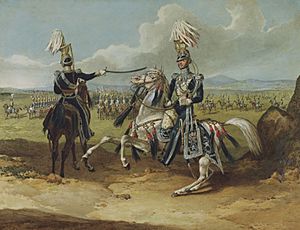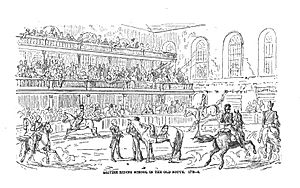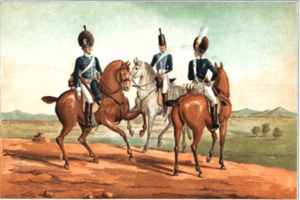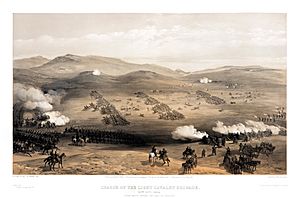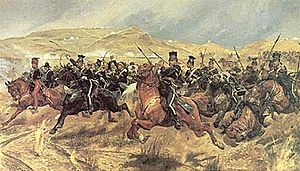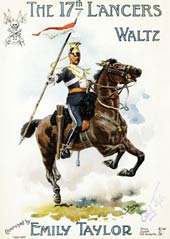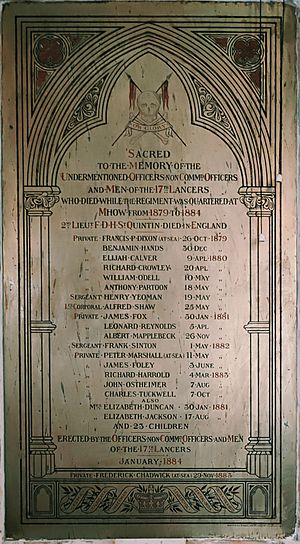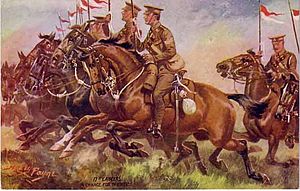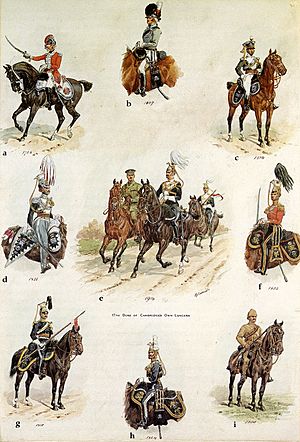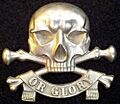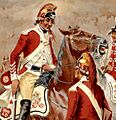17th Lancers facts for kids
Quick facts for kids 17th Lancers (Duke of Cambridge's Own) |
|
|---|---|
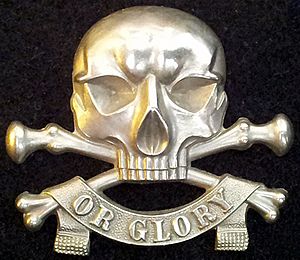
cap badge of the 17th Lancers
|
|
| Active | 7 November 1759 – 27 June 1922 |
| Country | |
| Branch | |
| Type | Line cavalry |
| Role | Lancer regiment |
| Nickname(s) | The Death or Glory Boys, The Horse Marines, The Tots, The White Lancers |
| Motto(s) | Death Or Glory |
| March | Quick: The White Lancers Slow: Occasional Overture |
| Anniversaries | Battle of Balaclava (25 October) Battle of Ulundi (4 July) |
| Commanders | |
| Notable commanders |
General Thomas Gage Major General Thomas Pelham-Clinton, 3rd Duke of Newcastle |
The 17th Lancers (Duke of Cambridge's Own) was a famous cavalry regiment in the British Army. It was formed in 1759. This regiment is well-known for its part in the Charge of the Light Brigade. This brave but risky charge happened during the Crimean War. In 1922, the 17th Lancers joined with the 21st Lancers. Together, they became the 17th/21st Lancers.
A Look Back: The Regiment's History
Starting Out: The Seven Years War
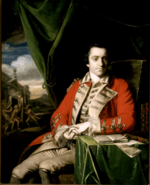
In 1759, Colonel John Hale was sent back to Britain. He carried important news about a big victory in the Battle of the Plains of Abraham. As a reward, he was allowed to create his own cavalry unit. He formed the regiment on November 7, 1759. It was first called the 18th Regiment of (Light) Dragoons. It was also known as Hale's Light Horse.
Colonel Hale chose a special symbol for the regiment's cap badge. It was a skull with the words "Or Glory". This showed how much his men admired General Wolfe. The regiment served in Germany in 1761. Later, it was renamed the 17th Regiment of (Light) Dragoons in 1763.
Fighting in the American Revolution
In 1775, the regiment went to North America. It arrived in Boston, which was under attack by American rebels. The regiment fought in the Battle of Bunker Hill in June 1775. This was a costly victory for the British. They also fought in other battles like Battle of Long Island and Battle of White Plains.
A part of the regiment joined a group called Tarleton's Legion. This group had both foot soldiers and cavalry. The 17th Light Dragoons kept their own identity. They even refused to change their red uniforms for the Legion's green ones. They faced heavy losses in the Battle of Cowpens in 1781. Here, they were surprised by American cavalry. The American War of Independence ended in 1783. An officer from the regiment delivered the news of peace to George Washington.
Wars with France
The regiment returned to Ireland. In 1795, they sailed to the West Indies. There, they helped fight against the French. Some troops also helped stop an uprising in Jamaica. Parts of the regiment even served on a ship, HMS Success. This experience at sea might be why they got the nickname "Horse Marines". They came back to England in 1797.
Napoleonic Wars and Becoming Lancers
In 1806, the regiment took part in a difficult mission. They went to South America, which was controlled by Spain. This was during the Napoleonic Wars. The British tried to capture Buenos Aires, but they failed. The regiment had to surrender and returned home in 1808.
Soon after, the regiment was sent to India. They fought in the Third Anglo-Maratha War in 1817. While in India, the British Army officially changed their role. They became "lancers" in 1822. This meant they would use lances, long spears, in battle. The regiment didn't even know about this change until 1823! They adopted a new uniform, including a special hat called a czapka.
In 1826, Lord Bingham became the regiment's leader. He spent a lot of his own money on new uniforms and horses. This led to another nickname for the regiment: "Bingham's Dandies".
The Crimean War: The Charge of the Light Brigade
In September 1854, the regiment arrived in Crimea for the Crimean War. They fought in the Battle of Alma. Then, in October 1854, they took part in the famous Charge of the Light Brigade. This happened at the Battle of Balaclava.
The 17th Lancers were in the first line of cavalry. They charged through Russian cannons and crashed into Russian cavalry. However, they didn't have enough soldiers to hold their ground. They had to retreat. The regiment lost many soldiers, 7 officers and 67 men. After the battle, they also took part in the Siege of Sevastopol.
After the war, three members of the regiment received the Victoria Cross. This is a very high award for bravery. The brave soldiers were Troop Sergeant-Major John Berryman, Sergeant-Major Charles Wooden, and Sergeant John Farrell.
Victorian Era Adventures
In 1857, the regiment went to India again. They helped stop the Indian Rebellion of 1857. Although the main fighting was over, they chased the rebel leader, Tatya Tope. During this chase, Lieutenant Evelyn Wood earned the Victoria Cross for his bravery. The regiment returned to England in 1865. In 1876, Prince George, Duke of Cambridge became their special leader. So, they added his name to their title. They became the 17th (The Duke of Cambridge's Own) Lancers.
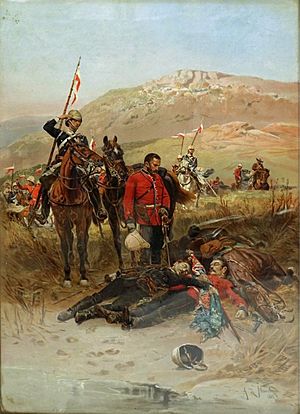
The regiment was sent to Africa for the Anglo-Zulu War. They fought in the Battle of Ulundi in July 1879. The regiment was inside a large square of British foot soldiers. When the Zulu attack seemed to slow down, the Lancers charged. Their charge broke the Zulu army and helped win the battle. They returned to India that same year.
The Second Boer War
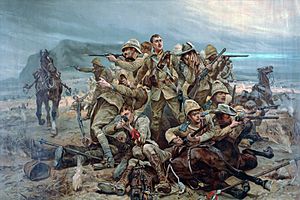
In 1900, a group of 500 soldiers from the regiment went to South Africa. They served in the Second Boer War. They missed the biggest battles. However, they still saw action. In 1900, Sergeant Brian Lawrence won the regiment's fifth Victoria Cross.
Their most important fight was at the Battle of Elands River in September 1901. A unit of Boers attacked C Squadron. The Lancers thought the Boers were friendly because of their clothes. But the Boers immediately opened fire. The Lancers lost many soldiers before they had to surrender. They stayed in South Africa until the war ended in 1902.
Serving in the First World War
At the start of the First World War, the regiment was in India. In November 1914, they arrived in France. They fought on the Western Front. The regiment used its cavalry skills at the Battle of Cambrai in 1917.
In 1918, they were used as mobile foot soldiers. They helped fill gaps in the lines during the German attacks. After the war ended in November 1918, they stayed in Germany. Later, they served in County Cork, Ireland. They were there during the Irish War of Independence. In 1920, Irish volunteers attacked their barracks in Mallow. They took weapons and freed prisoners. A British sergeant from the 17th Lancers was killed. This was the only British Army barracks captured during that war. In 1921, the regiment's full name became the 17th Lancers (Duke of Cambridge's Own).
Joining Forces: Amalgamation
In 1922, the 17th Lancers joined with the 21st Lancers. They formed a new regiment called the 17th/21st Lancers.
Regimental Museum
You can learn more about the 17th Lancers at The Royal Lancers and Nottinghamshire Yeomanry Museum. It is located at Thoresby Hall in Nottinghamshire.
Battle Honours
The regiment earned many "battle honours" for their bravery in different wars. These are like special awards for their service:
- Early wars: Alma, Balaklava, Inkerman, Sevastopol, Central India, South Africa 1879, South Africa 1900–1902
- First World War: Festubert, Somme 1916 1918, Morval, Cambrai 1917 1918, St. Quentin, Avre, Lys, Hazebrouck, Amiens, Hindenburg Line, St. Quentin Canal, Beaurevoir, Pursuit to Mons, France and Flanders 1914–18
Images for kids



